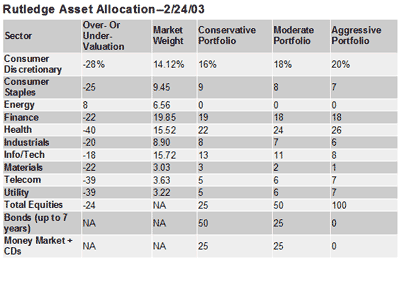This is a great time to
be a value investor. With war on our doorstep, hardware stores running
out of duct tape, oil prices hitting new highs and stock prices
collapsing, investors start feeling panicky. That's when people
sell good stocks for dumb reasons. That's when value investors make
the real money.
Today, value investors are buying great companies at bargain prices. According to our estimates at Rutledge Research, S&P large- and mid-cap stocks are 24% undervalued. Those industries in the eye of the governance scandal hurricane are the most undervalued: health care (40%), telecom (39%) and utilities (39%). The energy sector, in contrast, is 8% overvalued--reflecting investors' implicit but wrong-headed belief that oil prices will remain at today's high levels after the Iraq conflict has been resolved. You see what I mean when I say that bad news on the tube is good news for value investors. Intrinsic value is based on the simple, powerful and old-fashioned notion that investors commit capital to businesses in order to get paid--in dividends, capital gains or other distributions--out of the cash profits the business generates over its life. The intrinsic value of a business is simply the present value of the stream of free cash flow--after-tax cash profits less capital ploughed back in the business--that it will produce over its lifetime, less any debt or other obligations, divided by the number of shares. It is roughly what a knowledgeable investor would be willing to pay for a company if he knew he would own it forever. In short, buying stocks at below intrinsic value is what value investors crave. For the past ten years we have with considerable success used this framework to estimate the intrinsic value of the U.S. stock market. Our estimates are based on our judgments about future value drivers--the sales growth, profit margins, tax rates, capital requirements, interest rates and other parameters you must have to build financial statements for each future year. We draw these estimates from historical analysis of value drivers as well as from our economic forecast. Our most recent estimates, along with our current asset allocation recommendations, are shown in the table below.

Stock prices are like Lassie. They wander away from home for long periods, but eventually--usually within two years--return to intrinsic value. When they do, value investors make a killing. How to implement this strategy? You can easily build a portfolio of exchange-traded funds, or ETFs. These are exchange-traded index funds designed to mirror the performance of a sector--for example, iShares Dow Jones US Healthcare (amex: IYH), iShares Dow Jones US Telecommunications (amex: IYZ), iShares Dow Jones US Utilities (amex: IDU), iShares Dow Jones US Healthcare Consumer Non-Cyclical (amex: IYK) and iShares Dow Jones US Technology (amex: IYW). Simply overemphasize in this portfolio the most undervalued sectors. Or you can build a portfolio by choosing best-of-breed companies to represent each sector--for example, Pfizer (nyse: PFE - news - people ) for health care, SBC Communications (nyse: SBC - news - people ) for telecom, Colgate-Palmolive (nyse: CL - news - people ) for consumer staples, Microsoft (nasdaq: MSFT - news - people ) for technology and Citigroup (nyse: C - news - people ) for financials. Both approaches make sense in today's chaotic market. Either way, you will end up making money from the confusion and panic that is gripping the markets today. Don't miss out on the sale of the decade.
|

